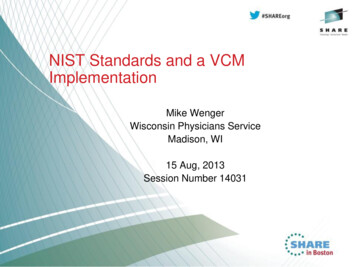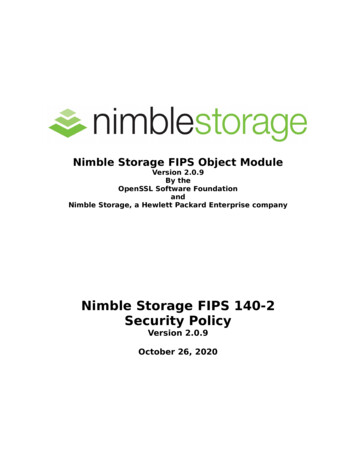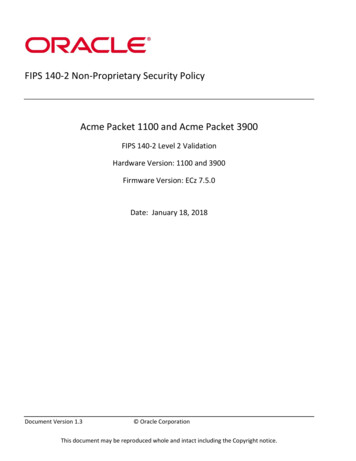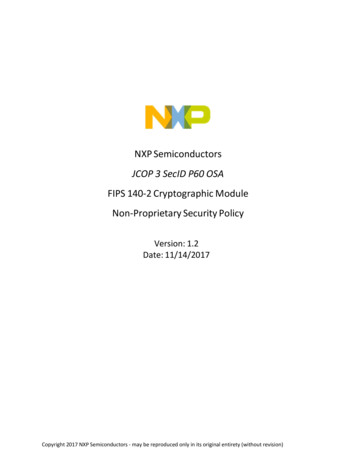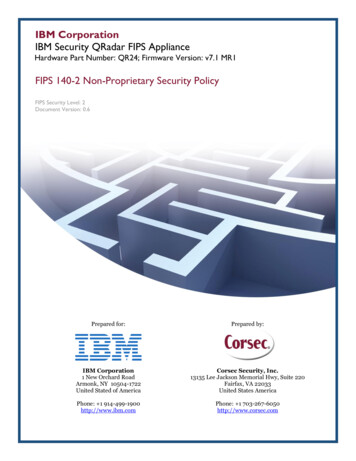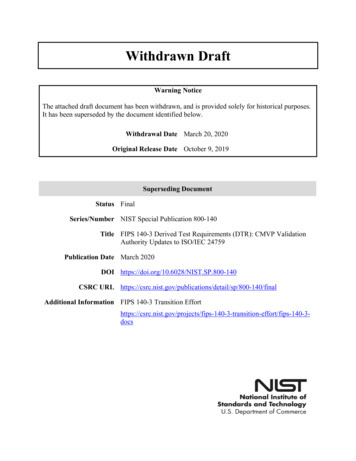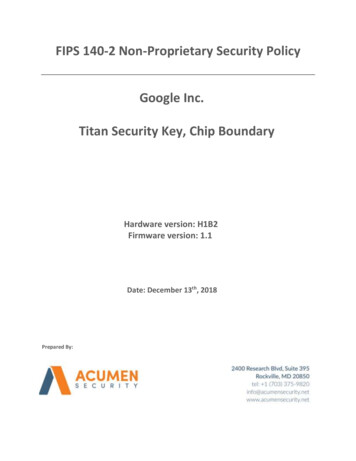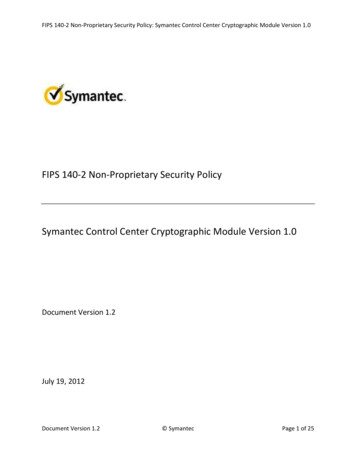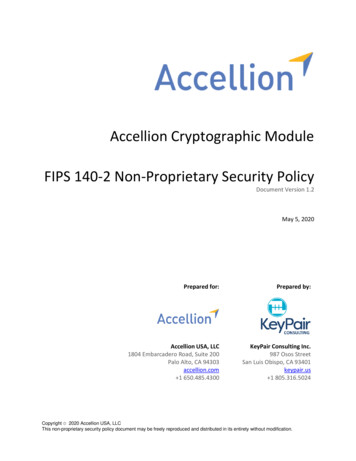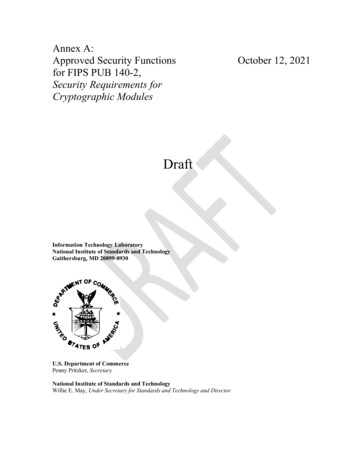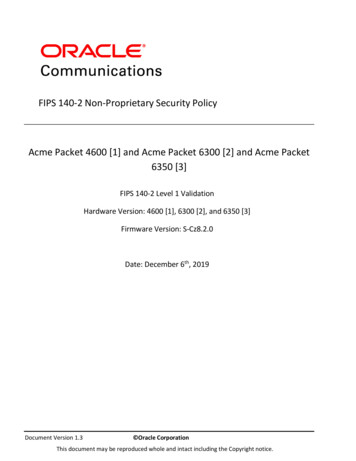
Transcription
FIPS 140-2 Non-Proprietary Security PolicyAcme Packet 4600 [1] and Acme Packet 6300 [2] and Acme Packet6350 [3]FIPS 140-2 Level 1 ValidationHardware Version: 4600 [1], 6300 [2], and 6350 [3]Firmware Version: S-Cz8.2.0Date: December 6th, 2019Document Version 1.3 Oracle CorporationThis document may be reproduced whole and intact including the Copyright notice.
Title: Acme Packet 4600 [1], Acme Packet 6300 [2] and Acme Packet 6350 [3] Non-Proprietary Security PolicyDate: December 6th, 2019Author: Acumen Security, LLC.Contributing Authors:Oracle Communications EngineeringOracle Security Evaluations – Global Product SecurityOracle CorporationWorld Headquarters500 Oracle ParkwayRedwood Shores, CA 94065U.S.A.Worldwide Inquiries:Phone: 1.650.506.7000Fax: 1.650.506.7200oracle.comCopyright 2019, Oracle and/or its affiliates. All rights reserved. This document is provided for information purposes only and the contentshereof are subject to change without notice. This document is not warranted to be error-free, nor subject to any other warranties orconditions, whether expressed orally or implied in law, including implied warranties and conditions of merchantability or fitness for aparticular purpose. Oracle specifically disclaim any liability with respect to this document and no contractual obligations are formed eitherdirectly or indirectly by this document. This document may reproduced or distributed whole and intact including this copyright notice.Oracle and Java are registered trademarks of Oracle and/or its affiliates. Other names may be trademarks of their respective owners.Acme Packet 4600, Acme Packet 6300 and Acme Packet 6350 Security Policyi
TABLE OF CONTENTSSection1.TitlePageIntroduction . 11.1Overview . 11.2Document Organization. 12.2.13.Acme Packet 4600 [1], Acme Packet 6300 [2] and Acme Packet 6350 [3] . 2Functional Overview . 2Cryptographic Module Specification. 33.1Definition of the Cryptographic Module . 33.2FIPS 140-2 Validation Scope . 43.3Approved or Allowed Security Functions . 43.4Non-Approved But Allowed Security Functions . 63.5Non-Approved Security Functions and Services . 73.6Vendor Affirmed Security Functions. 74.Module Ports and Interfaces . 85.Physical Security. 136.Operational Environment . 147.Roles and Services . 157.1Operator Services and Descriptions . 157.2Unauthenticated Services and Descriptions . 187.3Operator Authentication . 187.3.17.3.27.48.8.1Crypto-Officer: Password-Based Authentication .18User: Certificate-Based Authentication .19Key and CSP Management . 19Self-Tests . 27Power-Up Self-Tests. 278.1.18.1.28.1.38.1.48.1.5Firmware Integrity Test .27Mocana Cryptographic Library Self-Tests .27Oracle Acme Packet Cryptographic Library Self-Tests.27Nitrox Self-Tests .27Octeon Self-tests .288.2Critical Functions Self-Tests . 288.3Conditional Self-Tests . 289.Crypto-Officer and User Guidance . 299.1Secure Setup and Initialization . 299.2AES-GCM IV Construction/Usage. 3010.Mitigation of Other Attacks . 31Acronyms Terms and Abbreviations. 32References . 33Acme Packet 4600, Acme Packet 6300 and Acme Packet 6350 Security Policyii
List of TablesTable 1: FIPS 140-2 Security Requirements . 4Table 2: FIPS Approved and Allowed Security Functions for Oracle Acme Packet Cryptographic Library . 5Table 3: FIPS Approved and Allowed Security Functions for Oracle Acme Packet Mocana Cryptographic Library . 6Table 4: FIPS Approved and Allowed Security Functions for Cavium Nitrox . 6Table 5: FIPS Approved and Allowed Security Functions for Cavium Octeon . 6Table 6: Non-Approved but Allowed Security Functions . 7Table 7: Non-Approved Disallowed Functions . 7Table 8: Vendor Affirmed Functions . 7Table 9: Mapping of FIPS 140 Logical Interfaces to Physical Ports. 8Table 10: Physical Ports . 9Table 11: Mapping of FIPS 140 Logical Interfaces to Physical ports . 10Table 12: Physical Ports . 11Table 13: Service Summary . 15Table 14: Operator Services and Descriptions. 18Table 15: Operator Services and Descriptions. 18Table 16: Crypto-Officer Authentication. 19Table 17: User Authentication . 19Table 18: CSP Table . 26Table 19: Acronyms . 32Table 20: References . 33List of FiguresFigure 1: Acme Packet 4600 . 3Figure 2: Acme Packet 6300 . 3Figure 3: Acme Packet 6350 . 3Figure 4: Acme Packet 4600 - Front View . 9Figure 5: Acme Packet 4600 - Rear View. 9Figure 6: Acme Packet 6300 - Front View . 11Figure 7: Acme Packet 6300 - Rear View. 11Figure 8: Acme Packet 6350 - Front View . 12Figure 9: Acme Packet 6350 - Rear View. 12Acme Packet 4600, Acme Packet 6300 and Acme Packet 6350 Security Policyiii
1. Introduction1.1 OverviewThis document is the Security Policy for the Acme Packet 4600, the Acme Packet 6300 and the Acme Packet 6350appliances manufactured by Oracle Corporation. Acme Packet 4600, the Acme Packet 6300 and the Acme Packet6350 are also referred to as “the module” or “module”. This Security Policy specifies the security rules underwhich the module shall operate to meet the requirements of FIPS 140-2 Level 1. It also describes how the AcmePacket 4600, the Acme Packet 6300 and the Acme Packet 6350 appliances function in order to meet the FIPSrequirements, and the actions that operators must take to maintain the security of the modules.This Security Policy describes the features and design of the Acme Packet 4600, the Acme Packet 6300 and theAcme Packet 6350 modules using the terminology contained in the FIPS 140-2 specification. FIPS 140-2, SecurityRequirements for Cryptographic Modules specifies the security requirements that will be satisfied by acryptographic module utilized within a security system protecting sensitive but unclassified information. TheNIST/CCCS Cryptographic Module Validation Program (CMVP) validates cryptographic modules to FIPS 140-2.Validated products are accepted by the Federal agencies of both the USA and Canada for the protection ofsensitive or designated information.1.2 Document OrganizationThe Security Policy document is one document in a FIPS 140-2 Submission Package. The Submission Packagecontains: Oracle Non-Proprietary Security PolicyOracle Vendor Evidence documentFinite State MachineEntropy Assessment DocumentOther supporting documentation as additional referencesWith the exception of this Non-Proprietary Security Policy, the FIPS 140-2 Validation Documentation isproprietary to Oracle and is releasable only under appropriate non-disclosure agreements. For access to thesedocuments, please contact Oracle.Acme Packet 4600, Acme Packet 6300 and Acme Packet 6350Page 1 of 33
2. Acme Packet 4600 [1], Acme Packet 6300 [2] and Acme Packet 6350 [3]2.1 Functional OverviewThe Acme Packet 4600, the Acme Packet 6300 and the Acme Packet 6350 appliances are specifically designed tomeet the unique price performance and manageability requirements of the small to medium sized enterprise andremote office/ branch office. Ideal for small site border control and Session Initiation Protocol (SIP) trunkingservice termination applications, the Acme Packet 4600, the Acme Packet 6300 and the Acme Packet 6350appliances deliver Oracle’s industry leading ESBC capabilities in a small form factor appliance. With support forhigh availability (HA) configurations, hardware assisted transcoding and Quality of Service (QoS) measurement,the Acme Packet 4600, the Acme Packet 6300 and the Acme Packet 6350 appliances are a natural choice whenuncompromising reliability and performance are needed in an entry-level appliance. With models designed forthe smallest branch office to the largest data center, the Acme Packet ESBC product family supports distributed,centralized, or hybrid SIP trunking topologies.Acme Packet 4600, Acme Packet 6300 and Acme Packet 6350 appliances address the unique connectivity,security, and control challenges enterprises often encounter when extending real-time voice, video, and UCsessions to smaller sites. The appliances also helps enterprises contain voice transport costs and overcome theunique regulatory compliance challenges associated with IP telephony. TDM fallback capabilities ensurecontinuous dial out service at remote sites in the event of WAN or SIP trunk failures. Stateful high availabilityconfigurations protect against link and hardware failures. An embedded browser based graphical user interface(GUI) simplifies setup and administrationAcme Packet 4600, Acme Packet 6300 and Acme Packet 6350Page 2 of 33
3. Cryptographic Module Specification3.1 Definition of the Cryptographic ModuleThe module consists of the Acme Packet 4600, the Acme Packet 6300 and the Acme Packet 6350 appliancesrunning firmware version S-Cz8.2.0 on hardware platforms 4600, 6300 and 6350. The modules are classified as amulti-chip standalone cryptographic module. The physical cryptographic boundary for the Acme Packet 4600, theAcme Packet 6300 and the Acme Packet 6350 is all components with exception of the removable power supplies.A representation of the cryptographic boundary is defined as the chassis of the module as shown in the Figuresbelow:Figure 1: Acme Packet 4600Figure 2: Acme Packet 6300Figure 3: Acme Packet 6350Acme Packet 4600, Acme Packet 6300 and Acme Packet 6350Page 3 of 33
3.2 FIPS 140-2 Validation ScopeThe Acme Packet 4600 [1] and Acme Packet 6300 [2] and Acme Packet 6350 [3] appliances are being validated tooverall FIPS 140-2 Level 1 requirements. See Table 1 below.Security Requirements SectionCryptographic Module SpecificationCryptographic Module Ports and InterfacesRoles and Services and AuthenticationFinite State Machine ModelPhysical SecurityOperational EnvironmentCryptographic Key ManagementEMI/EMCSelf-TestsDesign AssuranceMitigation of Other AttacksLevel11211N/A1113N/ATable 1: FIPS 140-2 Security Requirements3.3 Approved or Allowed Security FunctionsThe appliances contain the following FIPS Approved Algorithms listed in Table 2 (Oracle Acme PacketCryptographic Library Acme Packet 4600, 6300 and 6350), Table 3 (Oracle Acme Packet Mocana CryptographicLibrary Acme Packet 4600, 6300 and 6350), Table 4 (Cavium Nitrox) and Table 5 (Cavium Octeon):Approved or Allowed Security FunctionsCert#Symmetric AlgorithmsAESCBC, ECB, GCM; Encrypt/Decrypt; Key Size 128, 256CTR; Encrypt; Key Size 128,256C 143Triple DES1CBC; Encrypt/Decrypt; Key Size 192C 143Secure Hash Standard (SHS)SHSSHA-1, SHA-256, SHA-384, SHA-512C 143Data Authentication CodeHMACHMAC-SHA-1, HMAC-SHA-256, HMAC-SHA-384, HMAC-SHA-512C 143Asymmetric Algorithms1Triple-DES was CAVP tested but is not utilized by the services associated with the Oracle Acme Packet Cryptographic Library.Acme Packet 4600, Acme Packet 6300 and Acme Packet 6350Page 4 of 33
Approved or Allowed Security FunctionsRSARSA: FIPS186-4:186-4 KEY(gen): FIPS186-4 Random eALG[ANSIX9.31] SIG(gen) (2048 SHA(1, 256 , 384)ALG[ANSIX9.31] SIG(Ver) (2048 SHA(1, 256, 384))Cert#C 143RSA: FIPS186-2 :ALG[ANSIX9.31] SIG(gen) (4096 SHA (256,384))ALG[ANSIX9.31] SIG(Ver) (2048 SHA(1, 256, 384)), (4096 SHA (1, 256, 384))RSA: FIPS186-4:186-4 KEY(gen):FIPS186-4 Random e ALG[ANSIX9.31] SIG(gen) (2048 SHA(1, 256 , 384), (4096 SHA(256,384))SIG(Ver) (2048 SHA(1, 256, 384))RSA: FIPS186-2Signature Verification 9.31:Modulus lengths: 2048, 4096SHAs: SHA-1, SHA-256, SHA-384ECDSAFirmware: FIPS186-4PKG: CURVES (P-256, P-384 Testing Candidates)SigGen: CURVES (P-256: (SHA-256, 384) P-384: (SHA-256, 384)SigVer: CURVES (P-256: (SHA-256, 384) P-384: (SHA-256, 384))C 143Random Number GenerationDRBGFirmware:CTR DRBG: [ Prediction Resistance Tested: Not Enabled; BlockCipher Use df: (AES256)]Hash Based DRBG: [ Prediction Resistance Tested: Not Enabled (SHA-1)C 143Key establishmentKey DerivationFirmware: SNMP KDF, SRTP KDF, TLS KDFC 143Key TransportKTSFirmware: KTS (AES Cert. # C 143 and HMAC Cert. # C 143; key establishment methodology provides 128 or256 bits of encryption strength);Table 2: FIPS Approved and Allowed Security Functions for Oracle Acme Packet Cryptographic LibraryApproved or Allowed Security FunctionsCert #Symmetric AlgorithmsAES2Triple DESCBC; Encrypt/Decrypt; Key Size 128, 256C 141CBC; Encrypt/Decrypt; Key Size 192C 141Secure Hash Standard (SHS)SHSSHA-1, SHA-256, SHA-384, SHA-512C 141Data Authentication Code2Per IG A.13 the same Triple-DES key shall not be used to encrypt more than 2 20 64-bit blocks of data.Acme Packet 4600, Acme Packet 6300 and Acme Packet 6350Page 5 of 33
HMACHMAC-SHA-1, HMAC-SHA-256, HMAC-SHA-384, HMAC-SHA-512C 141Asymmetric AlgorithmsRSARSA: 186-4:186-4 KEY(gen): FIPS186-4 Random e PKCS1.5: SIG(Ver) (1024 SHA(1); (2048 SHA (1))C 141Key EstablishmentKey DerivationSSH KDF, IKEv1/IKEv2 KDFC 141Key TransportKTSKTS (AES Cert. # C 141 and HMAC Cert. # C 141; key establishment methodology provides 128 or 256 bitsof encryption strength);Table 3: FIPS Approved and Allowed Security Functions for Oracle Acme Packet Mocana Cryptographic LibraryNote: P-384 for ECDSA was CAVP tested but is not utilized by the module’s services.Note: Triple-DES was CAVP tested but is not utilized by the services associated with the Oracle Acme PacketCryptographic Library Acme Packet for the 4600, 6300 and 6350. The services that are associated with OracleAcme Packet Cryptographic Library are SNMP, SRTP and TLS.Approved or Allowed Security FunctionsCert #Symmetric AlgorithmsAESCBC; Encrypt/Decrypt; Key Size 128, 2565257Triple DES3CBC; Encrypt/Decrypt; Key Size 1922659RSADP, Mod Size 20481728CVLCVLTable 4: FIPS Approved and Allowed Security Functions for Cavium NitroxApproved or Allowed Security FunctionsCert #Symmetric AlgorithmsAESECB; Encrypt/Decrypt; Key Size 128CTR; Encrypt; Key Size 1285256Key EstablishmentKey DerivationSRTP KDF1727Table 5: FIPS Approved and Allowed Security Functions for Cavium Octeon3.4Non-Approved But Allowed Security FunctionsThe following are considered non-Approved but allowed security functions:AlgorithmEC-Diffie-Hellman3UsageCVL Certs. #C143, #C141 and #1727, key agreement; key establishment methodologyPer IG A.13 the same Triple-DES key shall not be used to encrypt more than 2 20 64-bit blocks of data.Acme Packet 4600, Acme Packet 6300 and Acme Packet 6350Page 6 of 33
AlgorithmUsageprovides 128 or 192 bits of encryption strengthDiffie-HellmanCVL Certs. #C143, #C141 and #1727, key agreement; key establishment methodologyprovides 112 bits of encryption strengthRSA Key WrappingKey wrapping, key establishment methodology provides 112-bits of encryption strengthNDRNGUsed for seeding the NIST SP 800-90A Hash DRBG and CTR DRBG. Per FIPS 140-2 IG 7.14scenario 1 (a).The module provides a minimum of 440 bits of entropy input for the Hash DRBG. The inputlength for the CTR DRBG depends on the size of the AES key used. If the AES key length is 128bits, the seed size is 256 bits. If the AES key length is 256 bits, then the seed size is 384 bits.MD5 (TLS 1.0/1.1/1.2)MACing: HMAC MD5, Hashing: MD5Table 6: Non-Approved but Allowed Security Functions3.5 Non-Approved Security Functions and ServicesThe following services are considered non-Approved and may not be used in a FIPS-approved mode of operation:ServiceNon-Approved Security FunctionsSSHAsymmetric Algorithms: DSA, Symmetric Algorithms: Rijndael, AES GCM, 192-Bit AES CTRSNMPHashing: MD5, Symmetric Algorithms: DESSRTPHashing: MD5IKEv1/IKEv2Hashing: MD5, Symmetric Algorithms: 192-Bit AES CBCTLS 1.0/1.1/1.2Symmetric Algorithms: DESDiffie-HellmanKey agreement, less than 112 bits of encryption strength.RSA Key WrappingKey wrapping, less than 112 bits of encryption strength.Table 7: Non-Approved Disallowed FunctionsServices listed in the previous table make use non-compliant cryptographic algorithms. Use of these algorithmsare prohibited in a FIPS-approved mode of operation. These services are allowed in FIPS mode when usingallowed algorithms (as specified in section 9.1).3.6 Vendor Affirmed Security FunctionsThe following services are considered non-Approved and may not be used in a FIPS-approved mode of operation:AlgorithmCKGVendor Affirmed Security FunctionsIn accordance with FIPS 140-2 IG D.12, the cryptographic module performs Cryptographic KeyGeneration (CKG) as per SP800-133 (vendor affirmed). The resulting generated symmetric keysand the seed used in the asymmetric key generation are the unmodified output from an NISTSP 800-90A DRBG.Table 8: Vendor Affirmed FunctionsAcme Packet 4600, Acme Packet 6300 and Acme Packet 6350Page 7 of 33
4. Module Ports and InterfacesThe module interfaces can be categorized as follows the FIPS 140-2 Standard: Data Input InterfaceData Output InterfaceControl Input interfaceStatus Output InterfacePower InterfaceThe table below provides a mapping of ports for the Acme Packet 4600:Logical InterfaceData InputData OutputControl InputStatus OutputPowerPhysical PortsInformation Input/OutputCipher textEthernet SFP Ports (P0,1,2,3)Ethernet RJ-45 ports (P4 and P5)Ethernet MGT Ports(Mgmt0, Mgmt1, Mgmt2)Ethernet SFP Ports (P0,1,2,3)Ethernet RJ-45 ports (P4 and P5)Ethernet MGT Ports(Mgmt0, Mgmt1, Mgmt2)Ethernet SFP Ports (P0,1,2,3)Ethernet RJ-45 ports (P4 and P5)Console PortReset ButtonPower SwitchEthernet MGT Ports(Mgmt0, Mgmt1, Mgmt2)Ethernet SFP Ports (P0,1,2,3)Ethernet RJ-45 ports (P4 and P5)Console PortAlarm PortEthernet MGT Ports (Mgmt0, Mgmt1,Mgmt2)LEDsLCDPower PlugPlain textCipher textPlain textPlaintext control input via console port(configuration commands, operatorpasswords)Ciphertext control input via networkmanagement (EMS control, CDRaccounting, CLI management)Plaintext status output via consoleport.Ciphertext status output via networkmanagementN/ATable 9: Mapping of FIPS 140 Logical Interfaces to Physical PortsThe table below provides a mapping of ports for the Acme Packet 4600:Physical InterfaceConsole PortNumber of Ports1Description / UseProvides console access to the module. The module supports only oneactive serial console connection at a time.Console port communication is used for administration andmaintenance purposes from a central office (CO) location. Tasksconducted over a console port include: Configuring the boot process and management network Creating the initial connection to the module Accessing and using functionality available via the ACLIAcme Packet 4600, Acme Packet 6300 and Acme Packet 6350Page 8 of 33
Physical InterfaceNumber of PortsDescription / Use Alarm PortUSB PortsEthernetManagement portsSignaling and MediaEthernet ports113(Mgmt0, Mgmt1,Mgmt2)6(SFP P0,1,2,3RJ-45 P4, P5)Performing in-lab system maintenance (services describedbelow) Performing factory-reset to zeroize nvram and keysProvides status outputThis port is used for recovery. e.g. system re-installation afterzeroization.Used for EMS control, CDR accounting, CLI management, and othermanagement functionsProvide network connectivity for signaling and media traffic.These ports are also used for incoming and outgoing data (voice)connections.Table 10: Physical PortsFigure 4: Acme Packet 4600 - Front ViewFigure 5: Acme Packet 4600 - Rear ViewAcme Packet 4600, Acme Packet 6300 and Acme Packet 6350Page 9 of 33
The table below provides a mapping of ports for the Acme Packet 6300 and Acme Packet 6350:Logical InterfaceData InputPhysical PortsEthernet Ports (Slot 0 P0,1and Slot 1 P0,1)Ethernet MGT Ports(Mgmt0, Mgmt1, Mgmt2)Ethernet Ports (Slot 0 P0,1and Slot 1 P0,1)Ethernet MGT Ports(Mgmt0, Mgmt1, Mgmt2)Console PortReset ButtonPower SwitchEthernet Ports (Slot 0 P0,1and Slot 1 P0,1)Ethernet MGT Ports(Mgmt0, Mgmt1, Mgmt2)Console PortAlarm PortEthernet Ports (Slot 0 P0,1and Slot 1 P0,1)Ethernet MGT Ports(Mgmt0, Mgmt1, Mgmt2)LEDsLCDPower PlugData OutputControl InputStatus OutputPowerInformation Input/OutputCipher textPlain textCipher textPlain textPlaintext control input via console port(configuration commands, operator passwords)Ciphertext control input via network management(EMS control, CDR accounting, CLI management)Plaintext status output via console port.Ciphertext status output via network managementN/ATable 11: Mapping of FIPS 140 Logical Interfaces to Physical portsThe table below describes the interfaces on the Acme Packet 6300 and Acme Packet 6350:PhysicalInterfaceConsole PortNumberof Ports6300Numberof Ports635011Description / UseProvides console access to the module. The module supports only oneactive serial console connection at a time.Alarm Port11Console port communication is used for administration and maintenancepurposes from a central office (CO) location. Tasks conducted over aconsole port include: Configuring the boot process and management network Creating the initial connection to the module Accessing and using functionality available via the ACLI Performing in-lab system maintenance (services described below) Performing factory-reset to zeroize nvram and keys in FlashProvides status outputUSB Ports11This port is used for recovery. e.g. system re-installation after zeroization.Acme Packet 4600, Acme Packet 6300 and Acme Packet 6350Page 10 of 33
PhysicalInterfaceManagementEthernet portsSignaling andMedia EthernetportsNumberof Ports6300Numberof Ports6350Description / Use3(Mgmt0,Mgmt1,Mgmt2)3(Mgmt0,Mgmt1,Mgmt2)Used for EMS control, CDR accounting, CLI management, and other managementfunctions.42Provide network connectivity for signaling and media traffic.(Slot 0 P0,1 (Slot 0 P0,1 These ports are also used for incoming and outgoing data (voice) connections.and Slot 1 and Slot 1P0,1)P0,1)Table 12: Physical PortsFigure 6: Acme Packet 6300 - Front ViewFigure 7: Acme Packet 6300 - Rear ViewAcme Packet 4600, Acme Packet 6300 and Acme Packet 6350Page 11 of 33
Figure 8: Acme Packet 6350 - Front ViewFigure 9: Acme Packet 6350 - Rear ViewAcme Packet 4600, Acme Packet 6300 and Acme Packet 6350Page 12 of 33
5. Physical SecurityThe module’s physical embodiment is that of a multi-chip standalone device that meets Level 1 Physical Securityrequirements. The module is completely enclosed in a rack mountable chassis.Acme Packet 4600, Acme Packet 6300 and Acme Packet 6350Page 13 of 33
6. Operational EnvironmentThe modules support a limited modifiable operational environment as per the FIPS 140-2 Section 4.6.Acme Packet 4600, Acme Packet 6300 and Acme Packet 6350Page 14 of 33
7. Roles and ServicesAs required by FIPS 140-2 Level 2, there are three roles (a Crypto Officer Role, User Role, and Unauthenticated Role) in the module thatoperators may assume. The module supports role-based authentication, and the respective services for each role are described in the followingsections. The below tab
This document is the Security Policy for the Acme Packet 4600, the Acme Packet 6300 and the Acme Packet 6350 appliances manufactured by Oracle Corporation. Acme Packet 4600, the Acme Packet 6300 and the Acme Packet 6350 are also referred to as "the module" or "module". This Security Policy specifies the security rules under
